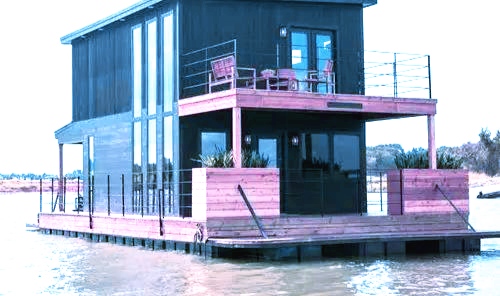Table of Contents
What is Floating House?
Floating house is a particular types of houses built on stationery deck. These types of houses can not move from one place to another place. The floating deck is designed in such a way that it can bear water huge pressure over the period of time.

Floating houses is a very innovative concept in the field of modern construction. These innovative houses utilise sea space instead of land.
Floating structures require more expensive raw material selection and advanced construction techniques, so they also require more expensive high-tech machinery. It also requires a more expensive skilled workforce, and since the whole system is relatively new to our culture, there must be a higher demand.
Floating houses are similar to traditional buildings and are often characterized as buildings built on water such that the stresses on the structure are equal to or less than the buoyancy of the water, allowing the house to float on water.
Floating Duck House
Floating duck house is a floating structures that ducks can climb or crawl into and provide shelter from predators such as foxes. Some are simple wooden huts on land, others are in duck ponds or lake islands.

They can be very ornate and/or large structures. Such houses are also used to allow birds to nest in safe and comfortable places. Dummy eggs, originally ceramic and now plastic, are used to encourage birds to lay in duck houses.
Types of Floating Houses
Normally two types of floating houses are constructed.
- Permanently Floating Houses.
- Flood Floating Houses.
1. Permanently Floating Houses
Permanently floating houses always float on the deck. This deck is made on the water. Houses are floats irrespective of environmental conditions. Permanently floating house can float with the help of deck but can not move from one place to another place.
2. Flood Floating Houses
Flood floating houses are designed in such a way that they can only float when high tide is nearby. Otherwise, it stays on the ground, especially in summer when there is no water. There are lots of places in USA state where you can found flood floating houses.
Working Concept
The side walls of the building are made of wood and iron. Steel pistons are used here to keep the whole structure from floating or sinking. During a flood, the entire building will remain floating.
The buoyancy concept behind the floating house allows it to be built without a foundation. For this reason, it is also called a floating house.
Building foundations should be designed to facilitate floating and to support dead loads, occupied loads, and other loads that a home may impose.
Houses can be built on top of boats, hollow tubes, light pads, or other similar elements that help float and carry loads.
Advantages of Floating Homes
The advantages of floating buildings are:
1. Easy to carry and affordable
Moving a floating building from one body of water to another in the same body of water is very easy and inexpensive.
2. Rapid construction
In addition to steel and wood, most of the floating structure’s components are assembled using precast technology. This greatly speeds up the construction process. Compared to the conventional construction method, the floating construction method can be constructed in about half the construction period.
3. Inexpensive
Savings on certain components and elements can lower the overall cost of construction, such as basics are omitted.
Floating structures are about 20-30% cheaper than traditional ones.
4. Reducing deforestation
Using water rather than land reduces the overall rate of deforestation.
5. Less disruption
Less disruption to the ecosystem
floating structures indirectly protect trees, wildlife and birds. This is how natural ecosystems are preserved.
6. Fun look
Compared to the appearance of common structures, floating buildings have a very attractive appearance.
7. Vulnerable to earthquakes
The water beneath floating buildings acts as a seismic damper, making these structures immune to earthquakes.
Disadvantages of floating buildings
The disadvantages of floating buildings are:
1. Locations with sudden changes in weather are dangerous
Building floating structures in areas with unpredictable weather is not recommended.
The depth of water bodies can increase or decrease significantly with climate change, which can pose serious problems.
2. High maintenance cost
Maintenance requirements for floating structures are much greater than for conventional structures. Most maintenance work should be completed before the rainy season begins.
3. Short life
Floating houses have a much shorter lifespan than land structures
4. High risk of water pollution
The fact that waste is quickly dumped into bodies of water is a major drawback of floating structures that contributes to water pollution.
5. High risk from tsunami
One of the biggest challenges for floating structures is the stress of high waves and tsunamis.
6. Need for skilled workers
It is difficult to maintain the center of gravity while maintaining buoyancy. Therefore, the personnel required to create floating structures must be highly qualified.
